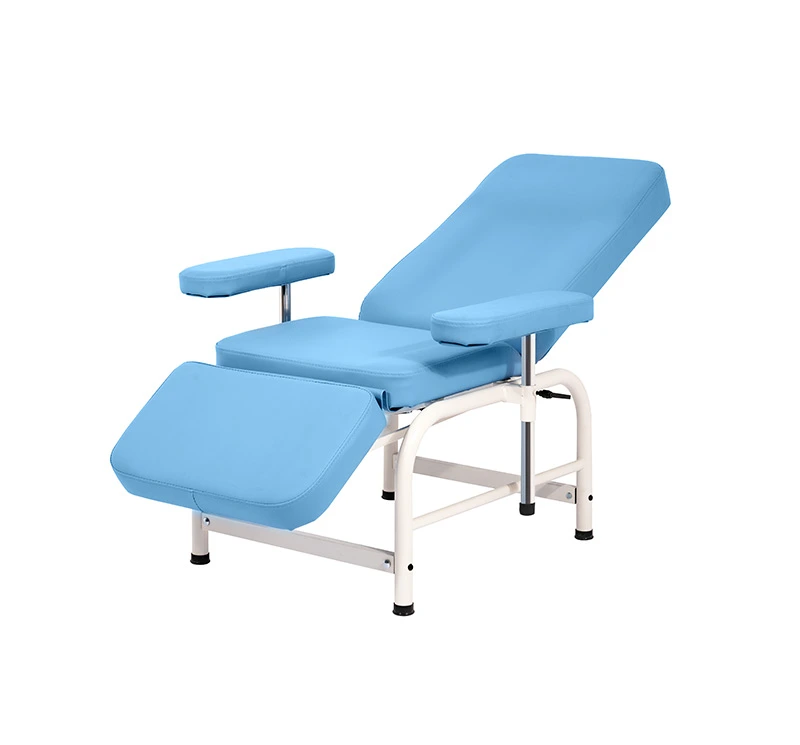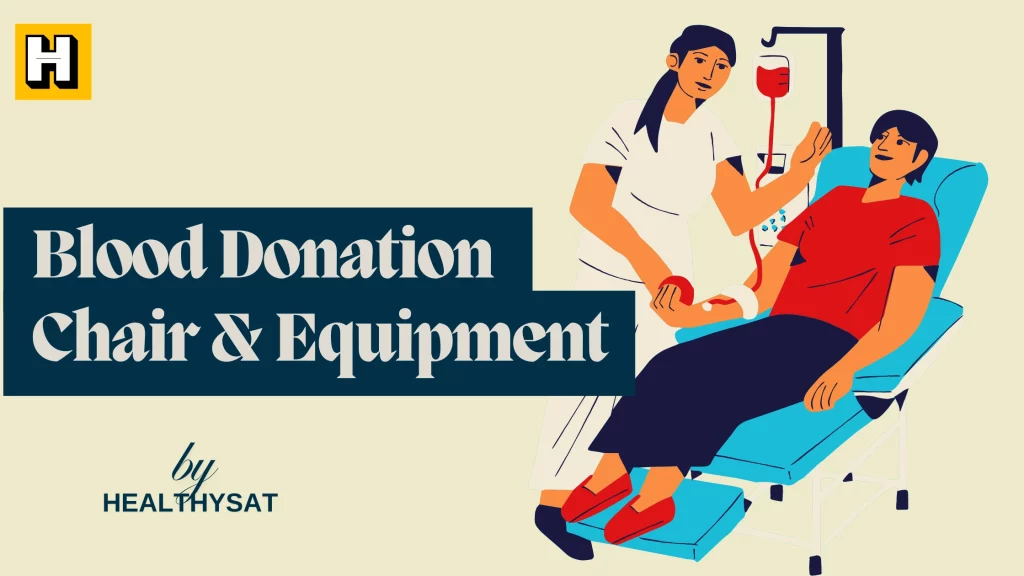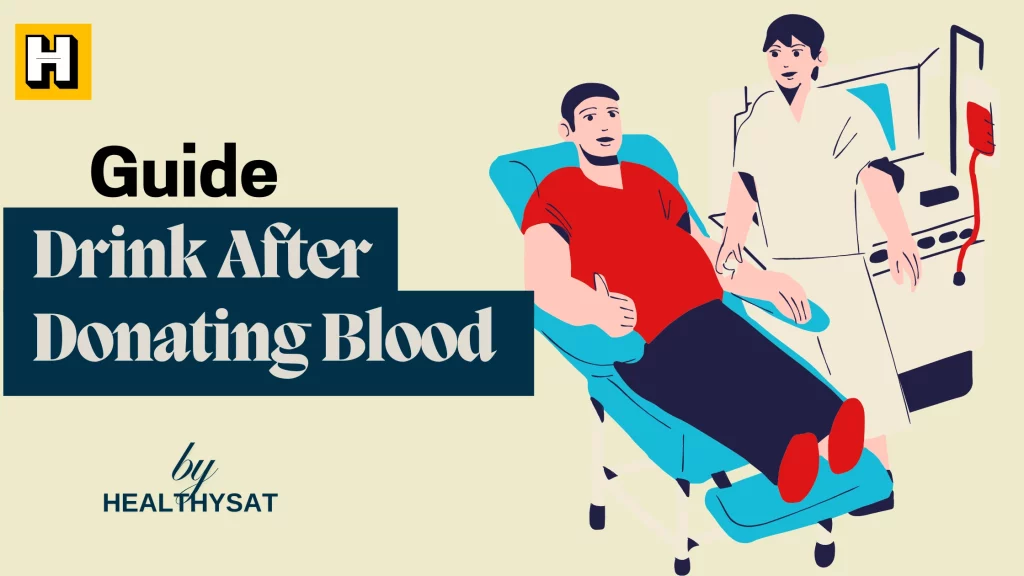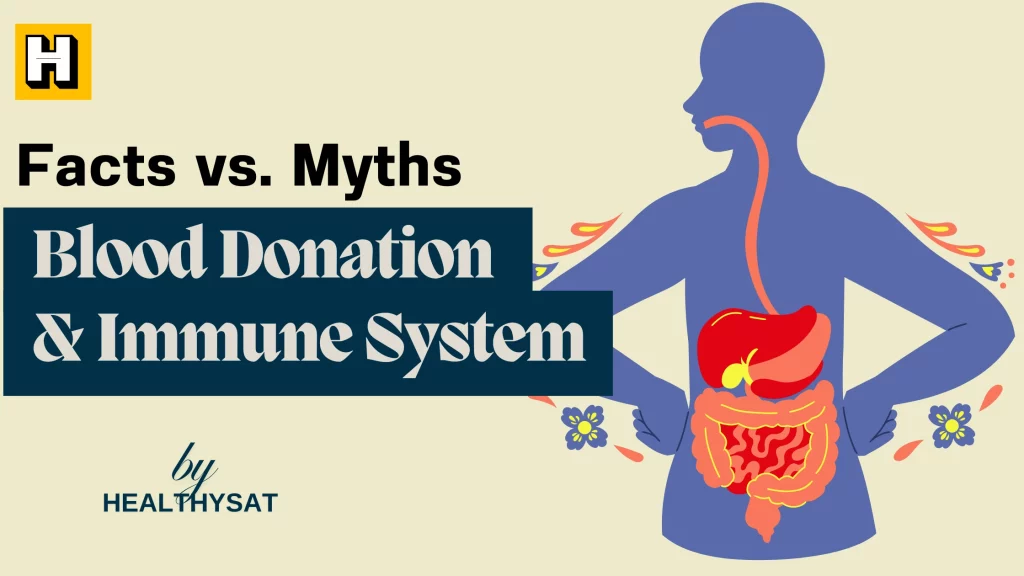Blood donation chairs are specially designed to keep the donor comfortable and safe during the blood collection process. If you’re thinking about donating blood, information can help erase anxiety for first-time donors thinking about chair equipment. The blood donation chair, needle sizes, and kits are designed to make your blood donation process comfortable and smooth as possible.
Many potential donors worry about what they will encounter during the donation. Will the blood donation chair be comfortable? How big is the needle used? What exactly is in a blood donation kit? This guide is designed to answer these questions so you feel prepared for your appointment to donate.
The equipment used for blood donation has come a long way. In today’s facilities, you will find modern chairs, safer needle systems and a standardized collection kit. If it is your first time donating blood or you are a regular donor, knowing about the equipment helps.
Blood Donation Chairs: Design & Features

The donation process starts and revolves around blood donation chairs. Blood donation chairs are engineered to help the donor be positioned for the process to be effective and safe while being comfortable.
NMIS 8 features adjustable blood donation chairs, which allow donors to sit upright initially, and then recline to semi-supine during donation. This positioning helps to minimize vasovagal happens (feel faint or light-headed) by ensuring proper blood flow to the brain during collection.
A typical blood donation chair contains a number of features:
- Adjustable headrest for proper head and neck support
- The arm rests are padded and extend outward to access the veins easily
- The emergency tipping feature quickly raises a donor’s feet if they feel faint
- Coming Soon
- Most weigh from 300 to 400 pounds so anyone can use
- Powered changes allow the staff to adjust the position smoothly without disturbing the donation
Updated blood donation chairs in modern facilities may also offer:
- For a more comfortable and pleasant experience during longer donations, memory foam cushioning
- Built-in massage capabilities to distract from the process
- Temperature-controlled surfaces to maintain donor comfort
- Digital controls that enable accurate positioning for different donation types
The chair’s design depends a bit on the donation type. Chairs used for platelet donation or double red cell collection often have additional features to accommodate the longer procedure time, such as extra cushioning and entertainment system mounts.
Blood donation chairs are designed to make the donation experience as easy as possible for donors, while also ensuring that phlebotomists can access them easily to do their job. The comfortableness of these chairs is necessary especially for first-time donors who are usually nervous about giving blood.
Needle Systems Used in Blood Donation

Comparison of blood donation needle sizes often surprises donors who expect a much larger needle than what is actually used. The needle that is used to donate whole blood is usually 16-gauge which helps blood flow easily while not being too uncomfortable.
To compare, below shows how blood donation needle size differs from other commonly available needles:
- Needle for blood donation: 16-gauge
- Regular IV catheter: 18-20 gauge (1.2-.09mm diameter)
- Needles for flu shot are small in size
- Insulin needle is a very thin needle
The needle used for blood donation is bigger than the needle that is used for vaccines or IVs, although the size of the blood donation needle is bigger, it is only because smooth flow should happen and there should not be and destruction should not happen to red blood cells. If the needle was smaller, the donation would take longer and could hurt the blood cells by forcing them out.
The needles used today for blood donations have many safety features:
- Ultra-thin wall technology that maximizes internal diameter while minimizes external diameter
- Needle tips with three bevels create a smooth entry
- Silicone coating that reduces friction during insertion
- The shields that prevent needle-stick injuries are built in as standard items
- Color coded hubs which helps to phlebotomists select the correct needle size
The needle post is equipped with a collection system consisting of flexible tubing and a diversion pouch for sample collection. Through this process, the first sample of blood is withdrawn for testing without interrupting the major collection process.
People who take blood are trained in the best techniques to make the donation most comfortable. The best vein, usually in the forearm area (inside of the elbow), is carefully chosen, and proper insertion techniques are used to minimise discomfort.
Most donors say that the insertion of the needle feels like a little pinch that goes away quickly. Most donors say the pressure is more uncomfortable than the pain, and once the needle is in, most say they don’t feel it.
Blood Donation Kit Components Explained

The kit for blood donation has all the sterile supplies needed for the safe collection of blood. Blood collection kits are standardized for use throughout all blood collection sites. Each blood donation kit is for single use only and opened just before your donation starts.
A comprehensive blood donation kit typically includes:
- Blood collection bag with anticoagulant solution
- Donor tubing set with needle and safety features
- Sample diversion pouch for initial blood collection
- Multiple sample tubes for testing
- Hemostats or clamps for controlling blood flow
- Gauze pads and bandages for post-donation care
- Antiseptic swabs for cleaning the venipuncture site
- Colored identification bands for labeling
- Tourniquets for vein location and access
The blood donation kit’s major component is the collection bag system. Modern bags for blood collection are made from medical grade PVC or other speciality materials. These bags have a specific amount of anti-coagulation and preservative solution that prevents clotting of blood and keeps it usable.
Different types of donations require specialized kits:
- The whole blood donation may be taken in a single
- To donate red blood cells the doctor requires special processing kit
- Platelet donation is done using kits compatible with automated cell separators
- Kits for plasma donation are specialized bags
To allow free flow of blood and to avoid hemolysis of blood (damage of red blood cells), the blood donation kit has tubing. The tubing is long so that a collection bag may be placed below the donor’s arm to assist in collection through gravity.
Each part of a blood donation kit is checked for quality and sterilized before packing. Every kit’s components are assured to be sterile since they are sealed and dated with an expiry date.
Blood banks keep tight control over the inventory of these kits and maintain the lot and expiration dates so that only current and well-maintained supplies are utilized. The provisions and important management of the blood donation kits and the regulated dating and failing of blood kits is discussed in this essay.
The Donation Process From Equipment Perspective
The experience of donating blood follows a given sequence in which each equipment is used for a purpose. When blood donors understand the process, they feel at ease with what to expect.
When you arrive for your appointment, usually the following happens:
- Registration through digital or paper medium to identify you
- Doctors use blood pressure cuffs, thermometers, and finger-stick hemoglobin testing equipment for health screening
- Questionnaire, which is often found on tablets or kiosks
- Preparation of the blood donation chair for your comfort
- Putting together and checking out the pieces of the kit used to give blood
- The place of donation is made ready with antiseptic solutions
The equipment work procedures during actual donation:
- Application of a tourniquet to make veins more visible
- Choosing a vein often with the help of infrared vein visualization at some center
- Cleansing of the donation site with antiseptic
- Venipuncture using the needle from the blood donation kit
- Collection of initial samples through the diversion pouch
- Main collection into the primary blood bag
- Periodic chair adjustments if donors report discomfort
- Monitor Equipment (Collection Weight and Flow Rate)
Post-donation, equipment-related steps include:
- Take the needle off and apply pressure to that spot
- Heat sealers seal and label the collection bags
- Proper disposal of used components in biohazard containers
- Cleaning of blood donation couch/chair for the next donor
During this entire process, blood center staff uses equipment and handles them according to protocol. Before using the equipment, they check each component and record it if something is wrong according to their quality control.
Modern donation centers are integrating more technologies into this process, including digital recording of incoming units, barcode scanning for precise tracking, and auto alerting for collection progress. Some centers allow the donor to trace the donation through testing and processing.
The entire equipment set-up is designed for optimal safety, efficiency and comfort while fulfilling all statutory requirements for collection. The chairs, needles and kits for blood donation work together as an integrated system to ensure a pleasant donation experience.
Special Equipment for Different Donation Types
Different types of blood donation require equipment other than the standard setup for whole blood collection. The chair for blood donation and fundamental safety protocols are much the same, but collection equipment differs a lot.
Platelet donation (apheresis) uses:
- Automated blood cell separators that isolate platelets
- Special kits come with return lines for other blood
- Some protocols incorporate dual-needle configurations (one for draw and one for return)
- Collection chambers specifically designed for platelets
- Pumps that mix solution exactly with drawn blood
- Fluid replacement solutions for donor comfort
- Special containers are used to collect platelets
Double red cell donation equipment includes:
- Blood cell processors that separate and return plasma
- Special nutrient solutions to replace lost volume
- Enhanced monitoring systems for donor safety
- Specialized collection kits with dual chambers
- Saline solution for volume replacement
Plasma donation requires:
- Plasma extraction equipment with specialized filters
- Automated systems for plasma and cell separation
- Return lines for cellular components
- Specialized collection bottles or bags for plasma
- Cold storage units for immediate processing
The blood donation chair is made to accommodate such special donations:
- Extended padding for longer procedure times
- Entertainment options like tablet mounts or TV screens
- Additional adjustment capabilities for extended comfort
- Specialized arm supports for dual-needle procedures
Needle systems may change a bit for specialized donations compared to whole blood collection:
- Slightly smaller gauges for some procedures
- Dual-needle systems in certain protocols
- Special coatings for repeated insertion/removal cycles
- Enhanced comfort features for longer procedures
Training refers to specialized types of donations that require staff to learn the protocols of new equipment. People who use these systems tend to get specialized certification, above phlebotomy certification.
Donors who donate these specialized types have said that the equipment may look more complicated, but the donation is still comfortable. The extra machines mainly work in the background to separate blood components while the donor is seated comfortably in the blood donation chair.
Blood Donation Equipment Safety Features
Today’s equipment has many safety features that help to keep the donor and the blood safe. Over the years, these systems have enhanced quite a bit in order to minimize risk and enhance care.
The blood donation chair includes crucial safety elements:
- Recline feature can be activated immediately if an donor feels faint
- There are locking mechanisms that stop any surprise movement during donation
- Stabilizing bases that prevent tipping or shifting
- Sealed surfaces that allow for thorough disinfection
- Support features that prevent falls when donors stand up
- Weight capacity ratings that ensure structural integrity
Needle systems have advanced safety features:
- The technology automatically retracts and protects the needles after use
- One-way valve systems that prevent backflow
- Color-coded components that prevent assembly errors
- Tamper-evident packaging that ensures sterility
- Lot tracking for quality control and recall management
- See-through parts let you check if blood is flowing right
Blood donation kits incorporate safety through:
- Sterile barriers that maintain integrity until use
- Standardized connections that prevent misassembly
- Clear labeling to prevent mix-ups
- Systems for sampling that allows closed collection
- Pre-measured anti-clots that save the blood
- Quality control testing of each production batch
Donation center safety equipment also includes:
- Systems that match donors to donations using barcodes
- Vital signs monitoring equipment to track donor wellbeing
- Storage for supplies and collected units which is controlled by temperature
- Calibrated scales that ensure proper collection volume
- Emergency response equipment readily available
- Specialized cleaning systems for equipment sanitation
Blood donation centers ensure that all equipment is checked prior to use. Before any donation takes place, the equipment must be first checked for any malfunctioning parts.
FDA and AABB (Association for the Advancement of Blood & Biotherapies) both define standards for blood donation equipment and inspect their facilities often. These organizations need proof of equipment care, testing, and performance check.
You can be assured that the equipment used today in blood donation centers is safe. Everything – from the collection chair to the tiniest component in the donation kit – is extensively tested and quality assured.
Comfort Features for Donors
Blood donation experience has become increasingly donor-centric with the integration of numerous comfort features in equipment design. Blood donation centres understand that comfortable donors are likely to return. It has led to many innovations in donor comfort.
The blood donation chair offers several comfort elements:
- Comfortable filling that relieves pressure during donation
- Adjustable to suit people of all shapes
- Headrests that can be positioned for optimal neck support
- Armrests that adjust for both height and angle
- Lumbar support that maintains proper spinal alignment
- Footrest extensions for taller donors
- Breathable upholstery materials that prevent overheating
Beyond the chair itself, donation centers often provide:
- Climate control systems for optimal room temperature
- Personal fans that donors can adjust
- Choices of TVs, tablets and reading materials
- Blankets for donors who tend to feel cold
- Stress balls or squeeze devices for the non-donation arm
- Adjustable lighting to reduce eye strain
- Privacy screens or curtains when preferred
Phlebotomists getting training for donor comfort, quicker now:
- Techniques to minimize needle discomfort
- How to properly position donors for maximum comfort
- Recognition of non-verbal discomfort cues
- Methods to distract donors during needle insertion
- Proper chair adjustment for different body types
- Communication approaches that reduce anxiety
Additional comfort measures are provided for first timers:
- More detailed equipment explanations
- Demonstration of the blood donation chair features
- Extra monitoring during the donation process
- Additional verbal reassurance and guidance
- Follow-up after donation to address any concerns
Now many centers record donor preferences in their systems so that they can set up the blood donation chair and environment according to each donor. This individual approach will greatly improve donation experience.
Most of the centers let concerned donors have a tour prior to the donation date for equipment comfort. Donors can check out the blood donation chair, needle systems and collection kits beforehand and soothe hesitations about the unknown and comforts before the donation date.
The blood banking industry has acknowledged that how comfortable or uncomfortable a donor is will affect the sustainability of the blood supply. Donors will return often if centers make the process as comfortable as possible.
Preparing for Your Donation: Equipment Questions to Ask
Before you arrive to donate, knowing about the equipment can help you relax and help the experience go smoother. Here are some important questions you might want to ask about the blood donation chair, needle, and kit when you book an appointment.
Questions about facility equipment:
- What kind of blood donation chairs do you utilize at your center?
- Are your chairs designed for people donating blood for the first time?
- Can the donation chair suit my height and weight adjustment?
- Do your donation chairs have special accommodations for comfort?
- What kind of entertainment options does one get in the donation chair?
Questions about the donation process and equipment:
- What is the thickness of the whole blood needle?
- “Can I check the blood donation kit contents before donation starts?”
- The length of time I will spend in the blood donation chair for this donation?
- What safety features does your blood donation equipment have?
- Is there any specific equipment I need to prepare for?
For donors with specific concerns:
- I have a fear of needles, can I use a distraction?
- I get chilly donatng, do you have blankets?
- “I’m worried about my back while sitting on the donation chair – can you help me out?”
- Can I ask for a particular phlebotomist to do my donation?
- Do you have a preferred arm position that works best with your equipment?
Most blood donation centers love such questions and provide very detailed information on their equipment. With advance notice, many facilities may be able to accomodate:
- Reserving a specific type of blood donation chair
- Meeting with a phlebotomist who is trained to manage donor anxiety
- Preparing comfort measures based on previous giving experiences
- Setting up your donation station with desired adjustments before your arrival
Please mention any equipment problems when you book your appointment. Blood centres strive to create a positive donation experience and know that familiarity with equipment helps make donors more comfortable.
If you’re really worried about the donation equipment, think about asking if you can stop by the centre before your appointment just to see. You can often take a tour of the facility to see donation equipment and lessen fear.
Remember, blood center personnel work with this material every day of the week and can answer technical questions about blood donation chairs, needle systems, and collection kits. You can trust blood centers to have done equipment testing and produce effective results.
FAQ About Blood Donation Equipment
Blood donation chairs have been made with comfort in mind. The blood donation chair are equipped with adjustable positions and ergonomic padding. A greater number of donors accept them (most comfortable) than medical examination tables.
Most people bring along their most trusted cuddly toy. This needle is slightly thicker than those used for vaccines, and it enables efficient blood flow without harming blood cells. The needle has a unique design to avoid causing pain.
Yes. Most donation centers allow you to bring your own distractions such as a book, phone, or tablet. Many places also have TVs, reading materials, or other distractions to keep you from looking at the machines.
You’ll spend 8-10 mins in the actual draw while donating blood for whole blood donation. Overall, around 20-30 minutes is spent on the chair for the complete process including resting and preparation.
Yes. The blood donation kit that is used is opened in your presence just before use for safety. You can check the kit and other equipment for freshness and sterility before blood donation.
If you don’t feel comfortable in the blood donation chair, the staff can adjust the chair while they donation is happening. The donation chairs can be adjusted to multiple positions; the phlebotomist can make these adjustments any time during your donation.
The basic equipment is the same, but many centers offer extra monitoring and support for first-time donors. Some centers have special booths or blood donation chairs with extra privacy for new donors.
The needle size cannot be altered for quality and quantity of blood. Phlebotomists are experienced at using the regular sized needle with small veins and can use certain techniques to make it work comfortably.
The chair that you will sit at for the blood donation is cleaned after every donor. The chairs have smooth surfaces so they can be fully cleaned.
Plasma donation uses special automatic machines that take plasma out of blood. Although the blood donation chair may be similar, you will be connected to a cell separator machine and the whole process will take longer.
Conclusion
When you understand the equipment being used, it helps you feel more relaxed to give blood. The needle and collection kit used for blood donation both create a hassle-free process. In addition, the precise system ensures safety in the entire collection of this vital resource.
The blood donation equipment used today has been in development for decades, and was designed for donor comfort. The most recent models of blood donation chairs at blood donation centers are more ergonomic and have additional positioning options for extra comfort. Needle systems have been designed to be large enough to facilitate effective blood collection yet adequately designed to minimize discomfort.
Being familiar with this apparatus could help lessen anxiety for potential blood donors. When you expect what happens—from the time you sit in the blood donation chair to when the bandage goes on—the more comfortable you can be.
Blood centres are open to questions about their equipment and are committed to making a positive donation experience. Whether you want to know which blood donation chair is being used, the needle size to other medical things or what items are in the kit being used to collect the donation, the staff can tell you.
When preparing for your appointment to donate, one thing to keep in mind is that every piece of equipment is part of a system that is designed to take care of you, while you provide a gift that will help others. The minutes spent on a blood donation chair can add years of life to those receiving blood products.
If you don’t want to donate, it doesn’t matter how easy the process is. The high-tech chairs, accurate needles, and standardized kits only ease the journey of your generous gift from your arm to others.





